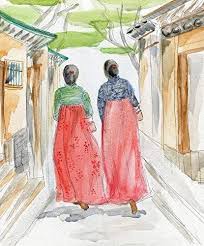 Tatum Shannon
Tatum ShannonKorean art includes a diverse range of art forms and styles that has its roots in stone age works dating back to 3000 BC. It is characterised by the use of bold colours, natural forms and surface decorations and the main mediums of expression include pottery, sculpture, painting and calligraphy. Many Korean artists have modified Chinese or Japanese traditions to create their own unique art style at the same time as transmitting historical aspects of both cultures.
Characteristics of Korean Art
The beauty and strength of Korean art lies in its sheer simplicity, spontaneity and its harmonious relationship with nature and natural forms. In this way, it is a lovely art from to engage with as it is not concerned with technical proficiency or perfection, instead the idea is to work closely with nature and bring out its natural and inherent characteristics in a simple and unadorned fashion. This creates lots of scope for creativity and subjective interpretation.
Early Korean painting
The objects of traditional Korean painting include Geisha’s, beautiful landscapes and animals and flowers. The paintings are generally simple yet are brought to life with some fine and intricate detail in parts as well as a range of bold and eye-catching colours. The history of Korean painting dates back to fourth century murals painted on tomb walls . Many of the early Korean painters travelled to China to study modern Chinese painting styles, which would eventually influence Japanese art as many Korean artists eventually migrated to Japan.
How to paint Korean style
In the past, Korean painting consisted primarily of chiese ink and dye on sheets of silk paper. It is also possible to create authentic looking Korean paintings using watercolour. Watercolour is a beautiful and natural looking medium that is particularly good to use for landscape paintings as well as bring different figures and portraits to life.
Watercolour can also be used to give an impressionistic feel to paintings which can work particularly well with landscapes and natural scenes. If you are new to painting, then watercolour is a great way in as you can get impressive results with little experience. However, it does help to have some knowledge and skills in drawing first which will increase the quality of the watercolour paintings that you produce.
Korean Calligraphy
Another good starting point for getting into Korean art is calligraphy. It requires few materials and it can be really satisfying and therapeutic. Traditional Korean calligraphy is created with a soft and flexible brush, dipped in black ink and drawn on white paper. The modern take on this are brush pens which are made of plastic with an ink reservoir and felt tip, these are easier to get hold of and to work with.
Investing in a range of brush pens with a different level of thickness and some good quality paper is enough to get you started. Control and steadiness, which is essential to good calligraphy is something that you will gain over time through practice. There are many online tutorials or guidebooks that you could use to help you while you are staring out.
 Art
Art